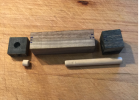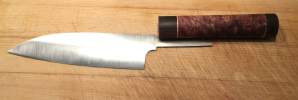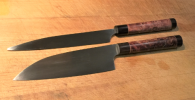- Joined
- Nov 14, 2018
- Messages
- 180
hi all this is frustrating situation.
i keep having issues with the blade not ending up straight on wa handle. i always use a small piece of dark wood a the top of the handle and the rest is a lighter color wood.I start with fairly square stock, mill the slot in the top wood piece and drill a 1/2 in hole from the bottom. Then i drill a 1/2 in hole in the larger handle portion. a 1/2 dowel is slotted with band saw and widen with sandpaper. everything looks good at this point so i glue up the handle and pull the blade out as it starts to cure. once it has cured i burn the tang back into the slot. i mark my lines to grind the handle to, grind it down, and but the blade back in to check if its still in line. Its not its crooked and no longer square to the handle. i just dont get it. ANy help with this would be greatly appreciated!!!
i keep having issues with the blade not ending up straight on wa handle. i always use a small piece of dark wood a the top of the handle and the rest is a lighter color wood.I start with fairly square stock, mill the slot in the top wood piece and drill a 1/2 in hole from the bottom. Then i drill a 1/2 in hole in the larger handle portion. a 1/2 dowel is slotted with band saw and widen with sandpaper. everything looks good at this point so i glue up the handle and pull the blade out as it starts to cure. once it has cured i burn the tang back into the slot. i mark my lines to grind the handle to, grind it down, and but the blade back in to check if its still in line. Its not its crooked and no longer square to the handle. i just dont get it. ANy help with this would be greatly appreciated!!!





